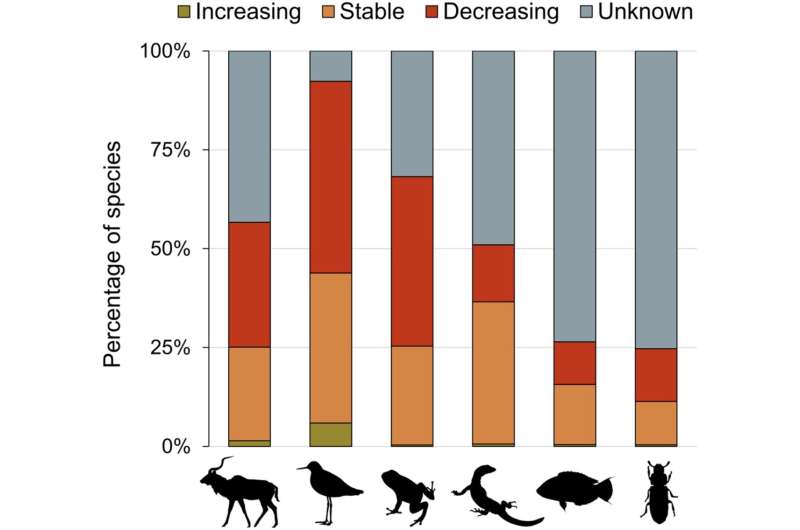Percentage of species per taxonomic group which have decreasing, stable, increasing or unknown/unassessed (NA) population trends. Each group is represented by a silhouette from left to right; mammals (N = 5969), birds (N = 11,162), amphibians (N = 7316), reptiles (N = 10,150), fishes (N = 24,356) and insects (N = 12,161). Data were sourced from the IUCN Red List (www.iucnredlist.org). Credit: Biological Reviews (2023). DOI: 10.1111/brv.12974
A trio of macro-biologists and life scientists, two with Queen's University Belfast and the third with Czech University of Life Sciences Prague, has found that the modern "sixth mass extinction" event is going to be even worse than prior research has shown.
In their study, reported in the journal Biological Reviews, Catherine Finn, Daniel Pincheira-Donoso and Florencia Grattarola, analyzed population trend data for more than 71,000 animal species to learn more about declines.
Over the past several decades, it has become clear that global biodiversity has been declining due to human activities including conversion of habitat, use of pesticides and herbicides and more recently, climate change. It is not known how many species are extinct due to such activities, but scientists have been trying to track species at highest risk of disappearing.
One organization, the International Union for Conservation of Nature (IUCN), has been assigning labels to species to assess extinction risk. But such lists, the researchers with this new effort note, only show which species are currently at risk of disappearing—they do not show the drop in population levels of species that are not currently at risk of going extinct. To learn more about such trends, the researchers analyzed available population data for more than 70,000 species around the world to see how their numbers have changed since recordkeeping first began.
They found that 48% of species have declining populations and just 3% have rising populations. They also found evidence showing that 33% of species currently classified as nonthreatened on the IUCN Red List are actually spiraling toward extinction.
The researchers also found that as a group, amphibians are seeing the greatest drops in population. And while they found declines for birds, mammals and insects, they found it was less severe among reptiles and fish. They also found that declines were steeper in the tropics, noting that species in such areas tend to be more sensitive to change.
The team concludes that the planet is approaching a mass extinction event far graver than prior research has suggested.
More information: Catherine Finn et al, More losers than winners: investigating Anthropocene defaunation through the diversity of population trends, Biological Reviews (2023). DOI: 10.1111/brv.12974
Journal information: Biological Reviews
© 2023 Science X Network
























